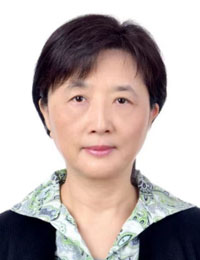HUANG Qian

HUANG Qian
MD. PhDAcademic Position: Professor of Pathology, Professor of Oncology
Email: qianh2011@126.com
Tel: 021-
Research Interests: In the past two decades, my research has mainly focused on two areas:
1)Basic research: Understanding the fundamental molecular mechanisms involved in tumorigenesis and tumor recurrence;
2)Translational research: Using PCR, NGS and liquid biopsy for tumor diagnosis at Molecular level.
Biography
Early on I studied molecular mechanism of retinoblastoma and the role of Rb gene in tumorigenesis of various types of tumor. I found different types of mutation in retinoblastoma tumor tissue and blood. We made poly- and monoclonal antibody against RB protein and found that RB protein was absent not only in retinoblastoma tumor tissue but also in some other types of tumor. Later on I modified mouse window chamber using GFP labeled tumor cells and observed tumor development from single cell and angiogenesis in vivo. Recently, I focus on tumor response to oncotherapy and made a series of discoveries on counterintuitive roles of apoptotic caspases that challenged the well-established paradigm. First, we elucidated the "Phoenix Rising" pathway where apoptotic tumor cells induced by X-ray or chemo- or target therapy could promote tumor repopulation. We discovered that caspase 3 stimulated tumor cell proliferation by cleaving its substrate such as iPLA2 or PKCδ then promoted PGE2 or VEGF production. Second, We show that cancer cells likewise enter a ‘radiation-tolerant persister’ (RTP) state to evade radiation pressure in vitro and in vivo. We also characterized RTP cells as enlarged cell size with complex karyotype, slow-cycling, activated type I interferon pathway and two gene patterns represented by CST3 and SNCG. We revealed a novel mechanism of tumor repopulation, i.e. cancer cell populations employ a reversible radiation-persistence by poly- and de-polyploidization to survive radiotherapy and repopulate the tumor, providing a new therapeutic concept to improve outcome of patients receiving radiotherapy.
Publications
Binjie Hu, Yanping Gong, Yulan Wang, Jianzhu Xie, Jin Cheng, Qian Huang. Comprehensive Atlas of Circulating Rare Cells Detected by SE-iFISH and Image Scanning Platform in Patients With Various Diseases. Front. Oncol. doi: 0.3389/fonc.2022.821454.
Zhengxiang Zhang , Xiao Feng , Zheng Deng , Jin Cheng , Yiwei Wang , Minghui Zhao , Yucui Zhao , Sijia He and Qian Huang. Irradiation-induced polyploid giant cancer cells are involved in tumor cell repopulation via neosis. Mol Oncol. 2021. doi:10.1002/1878-0261.12913.
Xinjian Liu, Xuhui Bao, Mengjie Hu, Hanman Chang, Meng Jiao1, Jin Cheng, Liyi Xie ,Qian Huang, Fang Li & Chuan-Yuan Li. Inhibition of PCSK9 potentiates immune checkpoint therapy for cancer. Nature 2020, 588: 693–698. Doi.org/10.1038/s41586-020-2911-7
Yiwei Wang, Minghui Zhao, Sijia He, Yuntao Luo, Yucui Zhao, Jin Cheng, Yanping Gong, Jianzhu Xie,Yulan Wang, Binjie Hu, Ling Tian, Xinjian Liu, Chuanyuan Li and Qian Huang. Necroptosis regulates tumor repopulation after radiotherapy via RIP1/RIP3/MLKL/JNK/IL8 pathway. Journal of Experimental & Clinical Cancer Research (2019) 38:461 doi.org/10.1186/s13046-019-1423-5
Jin Cheng, Sijia He, Min Wang, Ling Zhou, Zhengxiang Zhang, Xiao Feng,Yang Yu, JingjingMa,Chenyun Dai, Shengping Zhang, Lianhui Sun,Yanping Gong,YiweiWang, Minghui Zhao,Yuntao Luo, Xinjian Liu, Ling Tian, Chuanyuan Li, and Qian Huang. The Caspase-3/PKCd/Akt/VEGF-A Signaling Pathway Mediates Tumor Repopulation during Radiotherapy. Clin Cancer Res 2019, 25(12): 3732-43
Sijia He, Jin Cheng, Lianhui Sun, Yiwei Wang, Chuangui Wang, Xinjian Liu, Zhengxiang Zhang, Minghui Zhao, Yuntao Luo, Ling Tian, Chuanyuan Li and Qian Huang. HMGB1 released by irradiated tumor cells promotes living tumor cell proliferation via paracrine effect. Cell Death and Disease 2018,9:648. doi: 10.1038/s41419-018-0626-6.
Xiao Feng, Yang Yu, Sijia He, Jin Cheng, Yanping Gong, Zhengxiang Zhang, Xuguang Yang, Bing Xu, Xinjian Liu, Chuan-Yuan Li, Ling Tian, Qian Huang. Dying glioma cells establish a proangiogenic microenvironment through a caspase 3 dependent mechanism. Cancer Letters. 2017; 385: 12-20.
Xing-Peng Wang, Qian Huang, Chuan-Yuan Li. Caspase 3, friend or foe in cancer therapy? Science p67-68. Pushing the boundaries of scientific research: 120 years of addressing global issues.
Yang Yu, Ling Tian, Xiao Feng, Jin Cheng, Yanping Gong, Xianjian Liu, Zhengxiang Zhang, Xuguang Yang, Sijia He, Chuanyuan Li, Qian Huang. eIF4E-phosphorylation-mediated Sox2 upregulation promotes pancreatic tumor cell repopulation after irradiation. Cancer Letters 2016;375(1):31-38.
Jingjing Ma, Jin Cheng, Yanping Gong, Ling Tian, Qian Huang. Wnt signaling downregulated after sonic hedgehog activation negatively associates with tumor repopulation. Disease Model & Mechanism. 2015;8:385-391.
Xinjian Liu, Yujun He, Fang Li, Qian Huang, Takamitsu A. Kato, Russell P. Hall, and Chuan-Yuan Li. Caspase-3 Promotes Genetic Instability and Carcinogenesis. Molecular Cell 2015;58:284-296.
Jin Cheng, Ling Tian, Jingjing Ma, Yanping Gong, Zhengxiang Zhang, Zhiwei Chen, Bing Xu, Hui Xiong, Chuanyuan Li, Qian Huang. Dying tumor cells stimulate proliferation of living tumor cells via caspase-dependent protein kinase Cδ activation in pancreatic ductal adenocarcinoma. Mol Oncol. 2015;9(1):105-114.
Donato AL#, Huang Q#, Liu X, Li F, Zimmerman MA, Li CY. Caspase 3 Promotes Surviving Melanoma Tumor Cell Growth after Cytotoxic Therapy. J Invest Dermatol. 2014;134(6):1686-1692. doi: 10.1038/jid.2014.18. Epub 2014 Jan 16.(co-first author)
Feng Y, Bao W, Luo Y, Tian L, Chen X, Yi M, Xiong H, Huang Q. Phosphomimetic mutants of pigment epithelium-derived factor with enhanced anti-choroidal melanoma cell activity in vitro and in vivo. Invest Ophthalmol Vis Sci. 2012;53(11):6793-6802. doi: 10.1167/iovs.12-10326.
Zhang S, Wu J, Wu X, Xu P, Tian Y, Yi M, Liu X, Dong X, Wolf F, Li C, Huang Q. Enhancement of rAAV2-Mediated Transgene Expression in Retina Cells In Vitro and In Vivo by Coadministration of Low-Dose Chemotherapeutic Drugs. Invest Ophthalmol Vis Sci. 2012; 53(6):2675-2684. doi: 10.1167/iovs.11-8856.
Huang Q, Li F, Liu XJ, Li WR, He ZM, Peng YL, Shen JP, Wolf F, Han GW, Wang XJ, Thorburn A, Bedford J, Li CY. Caspase-mediated stimulation of tumor cell repopulation during Cancer Radiotherapy. Nature Medicine 2011;17:860-867.
Liu XJ, Qian QJ, Xu P, Wolf F, Zhang JF, Zhang DB, Li CY, Huang Q. A Novel Conditionally Replicating ‘‘Armed’’ Adenovirus Selectively Targeting Gastrointestinal Tumors with Aberrant wnt Signaling. Human Gene Therapy 2011;22:427–437.
Fang Li, Zhimin He, Jingping Shen, Qian Huang, Wenrong Li, Xinjian Liu, Yujun He, Frank Wolf and Chuan-Yuan Li. Apoptotic Caspases Regulate Induction of iPSCs from Human Fibroblasts. Cell Stem Cell 2010;7:508-520.
Fang Li, Qian Huang, Jiang Chen, Yuanlin Peng, Dennis R. Roop, Joel S. Bedford,6 Chuan-Yuan Li. Apoptotic Cells Activate the “Phoenix Rising”Pathway to Promote Wound Healing and Tissue Regeneration. Science Signaling 2010;3(110), ra13.
Xinjian Liu, Jinjun Li, Yuhua Tian, Ping Xu, Xiafang Chen, Kuangchen Xie, Zhengjun Qiu, Yufei Wang, Dabing Zhang, Frank Wolf, Chuanyuan Li, and Qian Huang. Enhanced Pancreatic Cancer Gene Therapy by Combination of Adenoviral Vector Expressing c-erb-B2 (Her-2/neu)-Targeted Immunotoxin with a Replication-Competent Adenovirus or Etoposide. Human Gene Therapy 2010;21:157-170.
Xunda Ji , Lin Cheng, Fang Wei, Huiming Li, Mengyun Wang, Yuhua Tian, Xiafang Chen, Yufei Wang, Frank Wolf, Chuanyuan Li, Qian Huang, Non-invasive Visualization of Retinoblastoma Growth and Metastasis via Bioluminescence Imaging. Invest Ophthalmol Vis Sci., 2009;50(12):5544-5551.
Qian Huang, XiuWu Zhang, He Wang, Bin Yan, Mark W. Dewhirst, and ChuanYuan Li. A novel conditionally replicative adenovirus vector targeting telomerase-positive tumor cells. Clinical Cancer Research 2004;10:1439-1445.
Chuan-yuan Li#, Siqing Shan#, Qian Huang#, Rod Brun, Jeniffer Lanzen, Kang Hu, Pengnian Lin, and Mark W. Dewhirst. Initial stages of tumor cell-induced angiogenesis: Evaluation via skin window chambers in rodent models. Journal of the National Cancer Institute 2000;92(2):143-147.(co-first author)
Qian Huang, Siqing Shan, Rod D. Braun, Jennifer Lanzen, Gopal Anyrhambatla, Garheng Kong, Michael Borelli, Peter Corry, Mark W. Dewhirst, and Chuan-yuan Li. Noninvasive visualization of tumors in radent dorsal skin window chambers. Nature Biotechnology 1999;17:1033-103.



